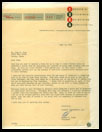
1964 letterhead
The information that follows is based on a video taped interview with Regency co-founder John R. Pies on May 12, 1991 and conversations since that time. Additional reference information has been added for continuity.
 xx
xx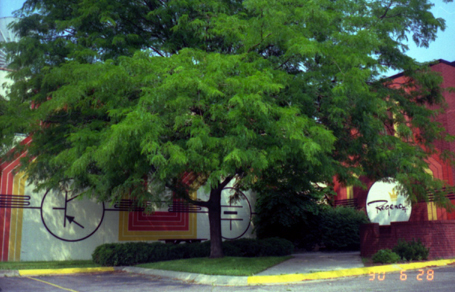
Regency Factory in Indianapolis, Indiana where the TR-1 was built. Left photo - 1953, right photo - 1990. CLICK to view a series of addtional factory photos & images between 1951 and 2012.
![]() September 1945 - The Beginning of
I.D.E.A./Regency
September 1945 - The Beginning of
I.D.E.A./Regency

![]() hear John Pies' recollection of I.D.E.A./Regency's beginnings 3:10 minutes
hear John Pies' recollection of I.D.E.A./Regency's beginnings 3:10 minutes
 W.W. II had just ended. RCA employees Joe
Weaver and John Pies were to be
transferred with their engineering group to Camden, New Jersey. John
was recovering from a collapsed lung and received a visit from Joe.
The visit led to a mutual decision to quit RCA and start their own
engineering consulting partnership company with the name I.D.E.A.,
Industrial Development Engineering Associates in Indianapolis.
W.W. II had just ended. RCA employees Joe
Weaver and John Pies were to be
transferred with their engineering group to Camden, New Jersey. John
was recovering from a collapsed lung and received a visit from Joe.
The visit led to a mutual decision to quit RCA and start their own
engineering consulting partnership company with the name I.D.E.A.,
Industrial Development Engineering Associates in Indianapolis.
 Ed
Tudor was hired in 1946 to stimulate markets for
IDEA and became president, along with radio designer George Fathauer. On July 18, 1947, the company formally
became a corporation. The group designed and built several products for midwest firms through the late 1940's and
finally started marketing their own creations. These products
included voltage signal boosters for countries using substandard voltage, resistors producted under I.D.E.A.'s Radell Division and a
television set. After building ten working television
sets in 1950, the project was dropped because I.D.E.A. was not
competitive against large companies like RCA. On the other hand, TV
reception was generally poor in rural areas and this led to the
company's first big money maker, a TV signal booster. The success of
the TV booster product line thrived when Sears contracted I.D.E.A. to
build signal boosters under the Sears' "Silvertone" label.
Ed
Tudor was hired in 1946 to stimulate markets for
IDEA and became president, along with radio designer George Fathauer. On July 18, 1947, the company formally
became a corporation. The group designed and built several products for midwest firms through the late 1940's and
finally started marketing their own creations. These products
included voltage signal boosters for countries using substandard voltage, resistors producted under I.D.E.A.'s Radell Division and a
television set. After building ten working television
sets in 1950, the project was dropped because I.D.E.A. was not
competitive against large companies like RCA. On the other hand, TV
reception was generally poor in rural areas and this led to the
company's first big money maker, a TV signal booster. The success of
the TV booster product line thrived when Sears contracted I.D.E.A. to
build signal boosters under the Sears' "Silvertone" label.
 The Monitoradio Division also was added to I.D.E.A. in the early 1950s, which built emergency frequency band receivers (FM, VHF, UHF) - this very successful division helped push company sales above fifty-million
dollars by 1980. The display of a FM Monitoradio Police Alarm PR-9 is shown here.
The Monitoradio Division also was added to I.D.E.A. in the early 1950s, which built emergency frequency band receivers (FM, VHF, UHF) - this very successful division helped push company sales above fifty-million
dollars by 1980. The display of a FM Monitoradio Police Alarm PR-9 is shown here.
Electronics seemed to be the future of the company
but the name Industrial Development Engineering Associates sounded
too much like a construction building contractor. One day during a
meeting to discuss the company name, Ed Tudor sat fiddling with a
pack of cigarettes that had a brand name called either Regent or Regency. Ed thought the regal name sounded classy and
this prompted the beginning of the Regency Division.
![]() hear John Pies discuss Regency's TV signal boosters 49 second audio
hear John Pies discuss Regency's TV signal boosters 49 second audio
xxxxxx
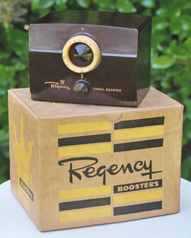 xxxx
xxxx
TV Signal Boosters were Regency's first major
product line. Left photo: late 1940s model DB-213. Center photo: mid-1950s DB-520.
A DB-520 booster is found just right of center on top of the
TV in right photo (photo taken in 1954, two months after release of the TR-1)
Spring 1954 - A Crucial Moment in History is Missed by the Giants
Vacuum tubes were king. Bell Labs' 1947 transistor invention (later to earn the Nobel Prize in 1956) was not taken seriously by the major radio manufacturers. Frequency response and power limitations were considered inherent show stoppers for the novel transistor. The up and coming transistor developer, Texas Instruments, needed to get transistors into the market place, but established electronics companies RCA, Sylvania and Philco did not take the bait. Regency had the vision and radio expertise, and TI had the transistor and financial backing. In early July 1954, the engineering and development of the TR-1 began at Regency.
TI also had a transistor radio circuit which Regency found not practical for the commercial market since the design required manually selecting matched components to make the radio operate. The Smithsonian displays TI's early prototype in its machined case. The prototype Regency TR-1 radios also used machined cases which had the same appearance as the molded cases used in the final production design. Nevertheless, cost per unit was prohibitive for the consumer market with the TI circuit design. Commercialized use of the transistor was still at bay.

![]() VIDEO INTERVIEW: John Pies describes Regency entering the transistor radio business 7:08 minutes (note: the actual price of the Regency TR-1 was $49.95, not $59.95 mentioned in this interview)
VIDEO INTERVIEW: John Pies describes Regency entering the transistor radio business 7:08 minutes (note: the actual price of the Regency TR-1 was $49.95, not $59.95 mentioned in this interview)

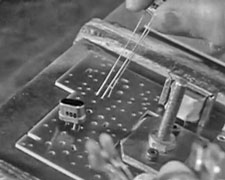 Regency's master
engineer, Dick
Koch (pronounced 'coke'), developed the
key circuit design that put the radio on the market. His circuit
allowed the tolerance of production run components to be directly
soldered into boards without manual selection.
Regency patented the historic design of the
Regency TR-1 radio with specific details given all the way down to
the electrical value of each component (patent number
2,892,931, submitted in 1955 and issued by
the U.S. Patent Office in 1959). This design is discussed in great
detail in an article titled "The
Revolution in Your Pocket" by Robert Simcoe in the 2004 fall issue of AMERICAN
HERITAGE's INVENTION & TECHNOLOGY (vol. 20, #2). In this article, Simcoe further
notes that the TR-1 triggered the miniature discrete components
market, and its compact design brought the first widely used
application of printed circuit boards into commercial
products.
Regency's master
engineer, Dick
Koch (pronounced 'coke'), developed the
key circuit design that put the radio on the market. His circuit
allowed the tolerance of production run components to be directly
soldered into boards without manual selection.
Regency patented the historic design of the
Regency TR-1 radio with specific details given all the way down to
the electrical value of each component (patent number
2,892,931, submitted in 1955 and issued by
the U.S. Patent Office in 1959). This design is discussed in great
detail in an article titled "The
Revolution in Your Pocket" by Robert Simcoe in the 2004 fall issue of AMERICAN
HERITAGE's INVENTION & TECHNOLOGY (vol. 20, #2). In this article, Simcoe further
notes that the TR-1 triggered the miniature discrete components
market, and its compact design brought the first widely used
application of printed circuit boards into commercial
products. ![]() hear Robert Simcoe 2004 NPR interview
hear Robert Simcoe 2004 NPR interview

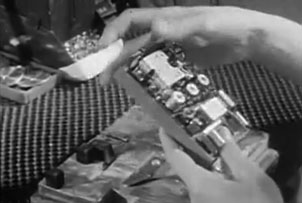 In mid-1955 the National
Association of Manufacturers recognized the importance of Regency's
achievement by producing a film featuring the production facilities
used to manufacture the TR-1. The film also credits the numerous suppliers that Regency contracted to create the minature components necessary for this pocket sized radio.
In mid-1955 the National
Association of Manufacturers recognized the importance of Regency's
achievement by producing a film featuring the production facilities
used to manufacture the TR-1. The film also credits the numerous suppliers that Regency contracted to create the minature components necessary for this pocket sized radio. ![]() CLICK TO VIEW FILM (film distributed by Global ImageWorks)
CLICK TO VIEW FILM (film distributed by Global ImageWorks)
Texas Instruments was not satisfied - TI wanted to claim the radio design was completely theirs. Regency owed TI a large sum of money and was encouraged to reduce that debt by selling the ownership of the patent for $25,000. TI president Erik Jonsson was personally involved with the negotiations to clear the Regency patent. Frank Mascarich, a Western Electric Patent Office attorney, was assigned to the job. Jonsson later told Regency's John Pies that his heart sank when Mascarich walked into the kick-off meeting. Mascarich looked at Jonsson and revealed "I know you, you are the guy who refused to hire me when I first got out of college."
Mascarich was a New York attorney from the younger generation and very impressed that Regency had a patent for an application of the transistor whereas most patents at the time were focusing only on the transistor itself. He commented "Regency was a thorn in the side of the industry which in-turn stimulated the practical application of the transistor." The established radio company giants could no longer ignore the inevitable fate of electronics evolution.
What was the Market Like?
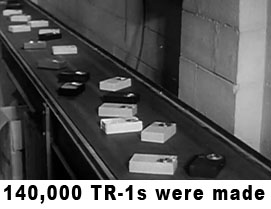
John Pies recalls that the October 1954 release of the Regency TR-1 missed a fair amount of Christmas sales since the production capacity was below the demand. The $49.95 tag may sound high for 1954 money, but it turned out to be a well targeted price many consumers would pay. On the other hand, profit margin was still so low that Regency struggled to keep going.
A Japanese company got wind of the business potential and entered the transistor radio business in September of 1955 with its own picnic portable radio, the TR-55. This led to the company's first big product success, and later, a domination of the miniature electronics industry. It's name was finally changed so Americans could pronounce it. The new name became Sony. Pies chuckles when recalling Sony's sales ploy after they announced release of the Sony TR-63 shirt pocket radio in 1957, stating "...so then they (Sony) came out and said we've made the smallest transistorized radio in the world, it'll fit in your shirt pocket, and then they equipped all their salesmen with shirts which had oversized pockets."
It should be further noted for the historical record that Sony's leaders created a deceptive myth in the 1970s and 80s that they had invented the first transistor radio; and shoddy reporting by CBS ("60 Minutes" show), NBC ("Today" show) and the BBC (spotlight show titled "Nippon") helped perpetuate that myth [click to read supporting background]…Sony history records have since corrected this misdirection.
In The Portable Radio in American Life, Michael Brian Schiffer writes "The importance of the TR-1 in stimulating demand for transistors was especially clear at IBM. Thomas J. Watson, Jr., head of IBM, bought several hundred of the new sets. Not only did he give TR-1s to various IBM executives, but he used them to goad his engineers into building computers with transistors. Comfortable with the familiar tube circuits, computer people had been reluctant to embrace the new technology. An impatient Watson finally ordered that IBM build no more machines with tubes after June 1, 1958. Whenever engineers complained about the decision to Watson, he just gave them a TR-1."
In the closing of Schiffer's book is written "It calls to mind the heroic efforts of Texas Instruments and I.D.E.A. to produce rapidly and market the world's first transistor radio. The achievement of the Regency TR-1 exemplifies what American engineers can accomplish under high pressure through teamwork."
Don Pies, son of John Pies

1957 letterhead
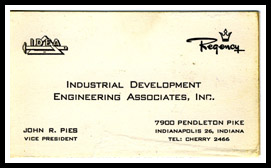 xxxxxxxx
xxxxxxxx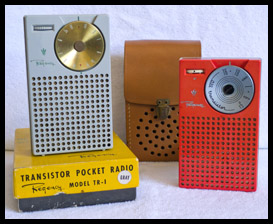
business card and personal TR-1 and TR-4
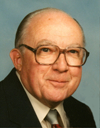
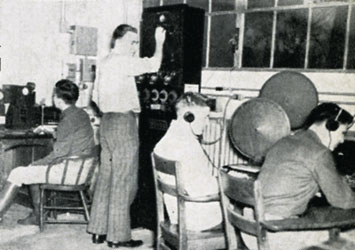 John
Pies (pronounced 'peas') graduated from Rose Polytechnic Institute (now called Rose-Hulman Institue of Technology) in Electrical
Engineering in 1939, and finally retired from the electronics
industry at 81 years old. He spent the final years of his career at
MicroFab Technologies near Dallas, where he was named on 10 patent awards.
John
Pies (pronounced 'peas') graduated from Rose Polytechnic Institute (now called Rose-Hulman Institue of Technology) in Electrical
Engineering in 1939, and finally retired from the electronics
industry at 81 years old. He spent the final years of his career at
MicroFab Technologies near Dallas, where he was named on 10 patent awards.
In 2001, he shared residence at the same Dallas care facility as transistor pioneer Gordon Teal. Teal had worked at Bell Labs with the original Bardeen, Brattain, Shockley transistor group, and then directed Texas Insturments' transistor research department in 1952. Shortly before reaching his 87th birthday, John Pies passed away on January 4, 2004.
Rose Poly photos: Upper right - Radio Cub, Pies standing. Lower left - College keepsakes and honors. Lower right - Electrical Engineering organization, Pies in lower left corner.
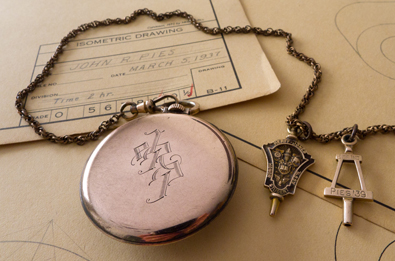 xxxx
xxxx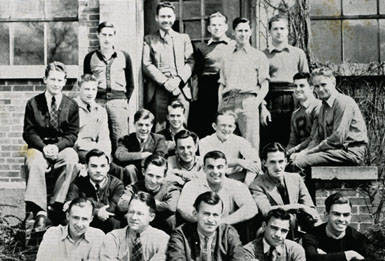
Footnotes:
John's wife, Alice, is credited with preserving many Regency archives, including media ads, company publications and John's personal letters with I.D.E.A./Regency employees.
The engineering interests continued within John Pies' family: his elder son, Dennis, designed and built lymphatic therapy instruments using Dennis' own circuit and optics designs under the Sky-David label; his younger son, Don, earned mechanical engineering degrees from both Texas Tech University and Ohio State University, and specialized his career designing and building telescope/optical systems riding on satellites; and his grandson, Matt (seen in the background in the Pies' video interview above), graduated from U.C. Berkeley in mechanical engineering and with a minor in software engineering.
postscript - Additional Regency Company Background
Japanese Competition Squeezed Regency Out of
the Portable Radio Business in the Early 1960's
Regency sadly conceded from the portable radio business as recorded
in the following announcement in a 1961 stock prospectus: "In the
course of the development of its transistor radios the Company was
granted three patents covering transistor circuitry. Though these
patents were subsequently assigned to Texas Instruments, Inc., the
Company reserved the right to use such patents and to grant licenses
to certain foreign corporations. It is believed that circuitry
contained in a majority of the transistor radios shipped into this
country by the Japanese infringe upon these patents. Steps have been
taken to recover damages as a result of this alleged infringement and
settlement negotiations have been commenced. Since the appearance of
the Japanese transistor radios in the United States the market for
the Company's models has steadily decreased. The severe price
competition brought about by the Japanese imports has compelled the
Company to gradually withdraw from the production of consumer
transistor radios."
Regency's Business Grew Despite the
Competition
Regency shifted its market direction and sales exceeded fifty-million
dollars in 1980. The company went through a number of confusing name
changes. Here is a timetable of some of the company's names and
organizations:
